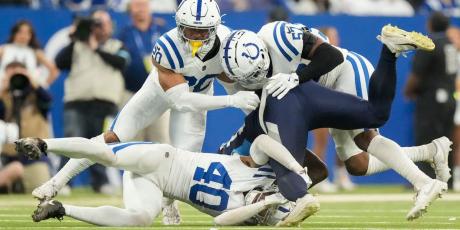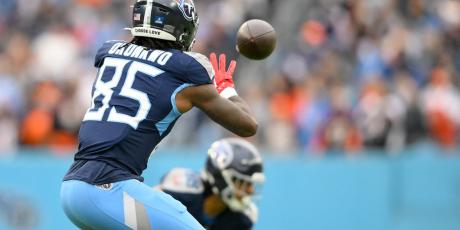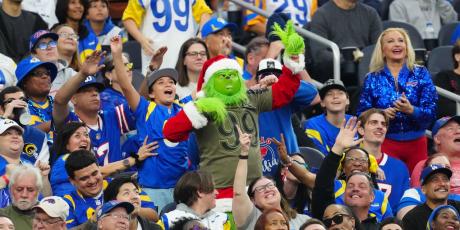QB Streaming: Efficiency, Volume and a Warm Blanket

Think of passing volume as the blanket dragged around by the kid who is, by every estimation, far too old for an object of such babyish comfort.
That would make efficiency the alternative: ripping the blanket away from the poor little kid and making him get by without the cloth appendage.
Sorry Linus.
Our quarterback streaming experiment in 2014 wasn’t quite as successful as it was in 2013. Frankly, I’m disappointed that my average quarterback selection for the quarterback streaming column posted QB9 numbers, with optimal plays putting up QB4 stats.
Volume and Its Harsh Lessons
The 2014 results aren’t exactly hateful, but reviewing my picks – especially during a dry run near the end of the season – revealed my central mistake: I chased volume instead of relying on efficiency. I grabbed that warm little blanket and held on with both hands. I reached for the comfort of knowing that some signal callers would have the so-called benefit of throwing the ball a lot in a game in which their team was a heavy underdog, or a contest projected by Vegas to be high scoring.
We used schedule-adjusted fantasy points (aFPA) throughout 2014, as we did in 2013, because – lest you need reminding – allowing 10 fantasy points to Derek Carr is not the same as giving up 10 points to Aaron Rodgers.
Below are the 10 defenses that gave up the most adjusted fantasy points to quarterbacks in 2014.
| Team/aFP | Pass attempts | Yards/attempt | Completion % | |
|---|---|---|---|---|
| Steelers (21.3) | 33.7 (9th) | 7.5 (29th) | 64.4 (22nd) | |
| Washington (19.9) | 32.5 (2nd) | 7.7 (30th) | 66.6 (28th) | |
| Raiders (19.4) | 33.6 (8th) | 7.1 (20th) | 63.7 (20th) | |
| Giants (19.4) | 32.6 (3rd) | 7.4 (24th) | 62 (13th) | |
| Bears (18.9) | 34.2 (17th) | 7.8 (31st) | 66.8 (30th) | |
| Colts (18.3) | 34.7 (19th) | 6.4 (10th) | 58.7 (6th) | |
| Broncos (18.2) | 40.3 (32nd) | 5.7 (1st) | 62.2 (14th) | |
| Chargers (17.9) | 32.8 (4th) | 6.5 (14th) | 61.1 (11th) | |
| Ravens (17.7) | 38.6 (30th) | 6.8 (17th) | 64.7 (25th) | |
| Eagles (17.0) | 36.9 (28th) | 7.2 (23rd) | 58.4 (3rd) |
Using Efficiency to Find Streaming Targets
I was well aware, headed in the 2014 campaign, that passing efficiency was closely correlated with fantasy production, as 4for4 DFS writer Chris Raybon showed in detail. Yards per attempt, in fact, was more closely correlated to fantasy points than all but four stats (touchdowns per game, touchdown percentage, and quarterback rating).
Pass attempts per game, on the other hand, had very little to do with fantasy point production. In other words, the thinking that massive volume – a quarterback who you believe will throw 40-50 times in a contest – is plainly and simply wrong.
There will always be exceptions, especially when we’re considering rushing quarterbacks who can pile up points on the ground, but volume is neither the way, nor the truth, nor the light in streaming signal callers.
Check out the commonalities among the defenses that were gouged by opposing quarterbacks last year. Washington faced a meager 32.5 passes per game, but gave up the third highest yards per attempt mark and the fifth highest pass completion percentage. When teams passed the pigskin against Washington, good things happened.
The postmortem evidence agrees. Josh McCown put up 20 fantasy points on 23 throws against Washington in Week 11 and Shaun Hill notched 16 fantasy points on just 22 pass attempts against Washington in Week 14.
Chicago’s defense was another one that faced very little throw volume, but continually proved a reliable streaming target. And once again, we see their yards per attempt and completion percentage were among the NFL’s most generous.
Denver and Indianapolis stand out as exceptions to the rule of efficiency over volume. Both teams gave up miniscule yards per attempt, but faced a ton of tosses every week. The Broncos faced at least 34 pass attempts in 14 of their 16 contests as teams played catch up against Peyton Manning and company while facing a pretty stiff Denver run defense (only Detroit gave up fewer rush yards per contest).
Perhaps that’s when we can carve out the exception to the rule we’ve established here: when a quarterback is primed to take on a juggernaut of an offense – like the Colts or the Broncos – we can skirt the volume over efficiency edict. It’s hardly ever the optimal play though.
If you require confirmation of this warm blanket effect, take a look at the defenses that allowed the fewest adjusted fantasy points to quarterbacks and look at how many yards per attempt they allowed.
Buffalo, which allowed the second fewest adjust points to signal callers, gave up just 5.9 yards per pass. No team gave up fewer schedule-adjusted points to quarterbacks than the Seahawks, who allowed 5.8 yards per attempt (to go along with a crazy-low 9.5 yards per completion).
Volume, Efficiency and a Sweet Spot
Defenses sometimes take a few weeks to reveal themselves as streaming quarterback targets. It’s not easy to grasp the volume vs. efficiency back and forth in the season’s first month. But these teams become apparent to savvy quarterback streamers, and I think it becomes an issue of trust.
Do you trust that efficiency will win out? Do you trust that passing efficiency is good process, while relying on volume is, at best, questionable process?
This isn't to say that those who stream the quarterback position should reflexively shy away from guys who might have a little volume of opportunity on their side in a given week. There certainly is a sweet spot in examining efficiency and volume, and that's part of our sometimes-maddening balancing act.
I’ll be committed to burning my warm blanket of pure passing volume in 2015. The aforementioned table, after all, has many useful lessons for us streamers. I think focusing more on efficiency could be a key in bettering this thing we call streaming.






















